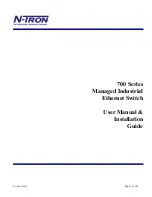
Segmentation
5-17
Ethernet
Figure 5-6. Bridges
The bridge is considered a node on the network and performs store and forward
functions for packets on each network. This contrasts with a repeater which
repeats the signal bit by bit from one side of the network to the other. The bridge
actually reads each packet, checks the packet for accuracy, then decides whether
the packet should be sent to the other network based on the destination address.
If the other network is busy, it is the responsibility of the bridge to store the
packet, for a reasonable time, until the transmission can be made.
The bridge is also responsible for handling collisions. If a collision happens as the
bridge is transmitting onto the second network, the bridge is responsible for the
back off and retransmission process. The original sending node is not made aware
of the collision. It assumes the packet has been sent correctly. If the bridge is
unable to send the packet to its final destination, the original sending station,
expecting some response from the device it was attempting to contact, will “time
out” and may attempt retransmission.
The bridge decides whether to forward or filter a packet based on the physical
location of the destination device with respect to the source device. A bridge
dynamically learns the physical location of devices by logging the source
addresses of each packet and the bridge port the packet was received on in a table
called the Source Address Table (SAT).
1706n26
Bridge
Network A
Network B
Summary of Contents for MMAC-5FNB
Page 1: ...Cabletron Systems Networking Guide MMAC FNB Solutions ...
Page 2: ......
Page 4: ...ii ...
Page 10: ...viii ...
Page 188: ...Expansion Ethernet 8 12 Port Assignment and Virtual LANs ...
Page 194: ...Expansion Token Ring 9 6 Port Assignment ...
















































